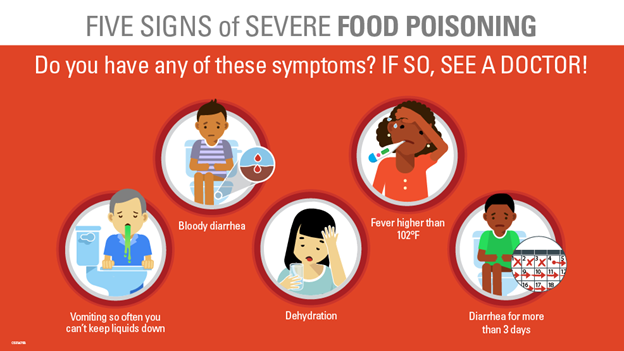Food poisoning, a common foodborne illness can hit hard with symptoms like diarrhea, fever, and vomiting. It’s a nasty surprise that can ruin your day or even your week. Understanding what causes it and how to prevent it is super important for keeping yourself and your loved ones safe. Nobody wants to end up feeling unwell after a meal, so let’s dive into what leads to food poisoning and how you can dodge it in future meals.
Food Poisoning Unpacked: A Deeper Insight
Food poisoning happens when you eat food contaminated with harmful germs. It’s more common than you might think. Millions of people fall sick each year because of it. The illness can range from a mild upset stomach to serious health problems that need medical care. It’s crucial to recognize the food sickness symptoms and know when things are getting serious. If you have severe symptoms like constant vomiting or a fever that won’t go away, it’s time to see a doctor.
Certain groups of people are more at risk. Children, older folks, and pregnant women need to be extra cautious. Their immune systems might not fight off germs as well as others. Keeping these loved ones safe means being extra careful about what they eat and how it’s prepared.
Understanding the Causes Behind Food Poisoning
Food becomes dangerous when it’s contaminated with germs. Here are some common causes:
- Bacterial Contamination: Some of the usual suspects are Salmonella, E. coli, and Campylobacter. These harmful bacteria sneak into food and drinks and can cause severe food intoxication symptoms.
- Viral Infections: Viruses like Norovirus and Hepatitis A are other troublemakers. They spread quickly and can lead to outbreaks.
- Parasitic and Chemical Contamination: Sometimes, food poisoning comes from parasites or chemicals in food. These are less common but can still cause severe symptoms.
Bacteria grow best in certain conditions. If food isn’t stored at the right temperature, or isn’t cooked thoroughly, it becomes a hotbed for germs. Raw ground beef or poultry can be especially risky. Germs also love damp and warm areas, making it crucial to keep food refrigerated and cooked correctly.
Preventing food poisoning involves recognizing these causes and taking steps to eliminate them. Washing hands, surfaces, and utensils while cooking can make a huge difference. Proper cooking kills harmful bacteria, and keeping raw and cooked foods separate helps avoid cross-contamination.
Sources of Contamination and Transmission Methods
Getting a grip on where contamination starts helps in preventing food poisoning symptoms.
- Food Production and Processing: This involves risks from how food is grown and processed. Dirty water used on crops can introduce harmful bacteria.
- Transportation and Storage: It’s vital that food is stored at the right temperatures to keep germs from multiplying. Any break in the cold chain can make food dangerous.
- Food Preparation Hazards: At home, poor preparation like not washing hands and surfaces, or using the same cutting board for raw chicken and salad, are big no-nos.
- Environmental Factors: Temperature and moisture play big roles in bacterial growth. Hot, humid conditions are perfect for germs. So, it’s crucial to handle and store food properly.
Understanding where contamination happens helps you take steps to stop these germs from making dinner a disaster.
Spotlight on High-Risk Foods
Some foods are more likely to cause problems than others:
- Raw meats, seafood, and unpasteurized dairy often carry higher risks because harmful germs love these foods.
- Leftovers stored improperly can become unsafe, fast. It’s important to cool them and store them correctly.
- Ready-to-eat foods need extra caution, especially if they’ve been sitting out for a while.
Staying smart about these foods will keep your meals safer and stomach happier.
Prevention Tactics: A Comprehensive Approach
Keep your kitchen safe with a few simple rules:
- Hygiene Matters: Wash hands, surfaces, and utensils. Keep your cooking area clean.
- Safe Food Handling: Use separate boards for different foods to avoid cross-contamination.
- Proper Storage: Refrigerate foods promptly and always check use-by dates.
- Fresh Choices: Pick fresh produce and be choosy about where and what you eat out.
Washing hands and being cautious about food choices go a long way in enjoying meals without worry.
Food Poisoning Treatment Options: What You Need To Know
Most of the time, food poisoning treatment happens at home:
- Drink plenty of fluids. Hydration is crucial when you have diarrhea or are vomiting.
- Over-the-counter remedies can help with mild food illness symptoms.
- Seek medical attention if symptoms are severe or persist. Sometimes, it’s more than just a mild case.
Knowing what to do helps quickly manage and reduce the distress of food poisoning symptoms.
Conclusion: A Final Word on Staying Safe
Keep up with safety habits and awareness to prevent food poisoning. These simple steps make dining a joy rather than a gamble. Stay vigilant and keep learning for a healthier, happier you.
Your Health, Our Service — Book an Appointment at Seva Clinic Today!



